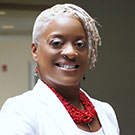As the HIV care continuum evolves, it is important to provide and build upon culturally competent care approaches for populations disproportionately affected by HIV.

This is a huge point of passion for Typhanye Vielka Dyer, PhD, MPH, an Associate Professor of the Epidemiology and Biostatistics Department at the University of Maryland School of Public Health in College Park, MD.
Her work is dedicated to the impact of psychological, social, and behavioral determinants of health as it relates to STI and HIV risk in the Black community – especially for Black women.
As an epidemiologist and health disparities scholar, her work is vital to advancing the state of health in Maryland.
Read the interview below to learn more about her work!
What inspired you to enter this field?
“After I graduated [from UCLA], I became a health educator for the Southern California Youth and Family Center in Inglewood. In that role, I was the person who would go out and deliver a curriculum for high school and middle school students to reduce their risk for STIs in pregnancy, and that’s how I began my journey.
I would just have these piles and piles of surveys that [students] filled out, but we weren’t doing anything with them. I was like, ‘I think we should probably try to analyze the data.’ And at this point, I only had a bachelor’s degree – I didn’t know what an MPH [Master of Public Health degree] was. I didn’t know what ‘public health’ was. At this same time, I had a family member who was diagnosed with HIV. So my interest in HIV started because I had questions.
It’s been my life’s mission ever since, and I will never stop doing this work until we stop dying and being diagnosed more than every other racial or ethnic group everywhere. I feel like I’ve been kind of called to do this work and it comes from the heart.”
What are some of the main things you have learned or noticed since entering this field?
“One thing that I’ve seen – I’ll be specific about the DMV area but also just in general – is that there’s more awareness around HIV. There’s more awareness about how people can engage in self-care and self-love to reduce their risk for transmission or acquisition of HIV. We’ve got PrEP; we’ve got all these biomedical interventions.
But at the same time, there’s still these underlying structural things – the stigma, the discrimination. Even though it’s been more than 30 years since HIV began, people still worry about how other people view them if they have HIV. There’s also stigma with respect to same-gender-loving folks, but even with that, I think there’s hope. I see awareness and hope in the Black community and a willingness to ask questions.”
What are your favorite and least favorite aspects of your work?
“My favorite aspect is the community of people that I’m able to impact – seeing the field grow, seeing mentees who go on to get their PhDs. It’s the community of people that I work with but also the community of people living with HIV.
I don’t really have a least favorite aspect, but I could say something a little cliche, which is that I wish there was more being done around funding initiatives. Very few people are funding racism-related things that have an impact on HIV rates in the Black community. And I think it’s a difficult question to answer because there are multiple factors that play into why we are where we are in 2023 with the rates of HIV. And it’s not even just a racial or ethnic thing – I think it’s a lack of resources, it’s environmental.”
What do you hope to see in the future of the HIV care and prevention field in the DMV area?
“Bringing it back to Black women. I think we’re the population of people that have been systematically left out of the discourse around HIV and our own sexual and reproductive health, and I don’t know why. I think that as a community, we have all of these other needs that compete with our need for self-love and self-care. All of that is mired in racism and sexism and all those things.
“So we’ve got this multilevel thing that needs to happen in order to improve access to care. We’ve got the personal, like how we deliver messages to people. We’ve got the interpersonal. We’ve got our networks and support groups, then we’ve got the system. [We consider]: “What does it feel like when I go to see my primary care physician? Am I greeted with love and support?” That’s going to determine whether someone seeks healthcare.”
What advice would you give to providers who are trying to expand their work and incorporate key populations into their methodologies?
“I can’t really tell providers what to do because I’m not in that space, but I say start with the community. People know what they need and what they don’t need. Listen and really hear what [they’re] saying. I tell my students: “When public health is working, you don’t see it.” Public health is the invisible thing that, when it’s working, 14,700 people don’t die from automobile accidents because public health made it mandatory to wear a seatbelt. You don’t know that that many deaths have been prevented, but we as public health workers do.
But I think clinicians should be more involved in the prevention piece. If you get a chance to sit one on one with a patient and they’re presenting with hypertension but they’re coming in with a bruise or something, treat the whole person versus just that one thing. I think learning about population health and what’s going on is critical to be a really good primary health care provider for your patients.”
